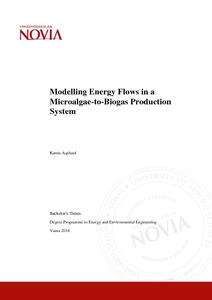Modelling Energy Flows in a Microalgae-to-Biogas Production System
Asplund, Katrin (2018)
Asplund, Katrin
Yrkeshögskolan Novia
2018
All rights reserved
Julkaisun pysyvä osoite on
https://urn.fi/URN:NBN:fi:amk-2018060512620
https://urn.fi/URN:NBN:fi:amk-2018060512620
Tiivistelmä
The aim of the study was to create a top-down model of a theoretical, full-scale microalgae-to-biogas production system with the help of the life cycle software GREET. The model was created for the purpose of calculating the energy balance and evaluate the energy performance of a defined algae product system, and the software and its applicability to the needs of the project employer was further evaluated.
The approach of a life cycle inventory study (LCI) was taken, and the inventory data was obtained from the literature as well as from previous findings within the project. The functional unit was defined as “the production of 1 MWh of biogas in a microalgae-to-biogas system” and the product system included the processes of microalgae cultivation, harvesting and biogas production through anaerobic digestion.
Findings of the LCI study indicated that for the given set of process criteria, the energy going in to the system was higher than the energy coming out, hence causing the energy balance to be negative. However, further work with modelling different scenarios should be done in order to better understand and optimize the system. Målet med studien var att skapa en top-down modell av ett teoretiskt, fullskaligt mikroalg-till-biogas produktionssystem med hjälp av livcykelprogramvaran GREET. Ändamålet med modellen var att beräkna energibalanser och utvärdera ett definierat algproduktionssystems energiprestanda. Programvaran GREETs ändamålsenlighet för uppdragsgivarens behov granskades även.
Metodologiskt sett, utfördes arbetet som en livscykel- inventeringsstudie (LCI), där inventariedatan erhölls från litteraturstudier såväl som från tidigare projektresultat. Den funktionella enheten definierades som ”produktionen av 1 MWh biogas inom ett mikroalg-till-biogas produktionssystem”, och det studerade systemet innehöll processer av mikroalgsodling, skördning samt biogasproduktion genom anaerob rötning.
Resultaten av LCI-studien påvisade att energiströmmarna in i systemet var större än energiströmmarna ut ur systemet för de studerade processkriterierna, vilket resulterade i en negativ energibalans. För att bättre förstå och kunna optimera systemet behöver mera arbete läggas på att modellera olika processer och scenarion.
The approach of a life cycle inventory study (LCI) was taken, and the inventory data was obtained from the literature as well as from previous findings within the project. The functional unit was defined as “the production of 1 MWh of biogas in a microalgae-to-biogas system” and the product system included the processes of microalgae cultivation, harvesting and biogas production through anaerobic digestion.
Findings of the LCI study indicated that for the given set of process criteria, the energy going in to the system was higher than the energy coming out, hence causing the energy balance to be negative. However, further work with modelling different scenarios should be done in order to better understand and optimize the system.
Metodologiskt sett, utfördes arbetet som en livscykel- inventeringsstudie (LCI), där inventariedatan erhölls från litteraturstudier såväl som från tidigare projektresultat. Den funktionella enheten definierades som ”produktionen av 1 MWh biogas inom ett mikroalg-till-biogas produktionssystem”, och det studerade systemet innehöll processer av mikroalgsodling, skördning samt biogasproduktion genom anaerob rötning.
Resultaten av LCI-studien påvisade att energiströmmarna in i systemet var större än energiströmmarna ut ur systemet för de studerade processkriterierna, vilket resulterade i en negativ energibalans. För att bättre förstå och kunna optimera systemet behöver mera arbete läggas på att modellera olika processer och scenarion.
